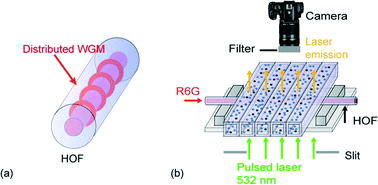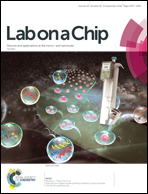Distributed fibre optofluidic laser for chip-scale arrayed biochemical sensing†
Abstract
Optofluidic lasers (OFLs) are an emerging technological platform for biochemical sensing, and their good performance especially high sensitivity has been demonstrated. However, high-throughput detection with an OFL remains a major challenge due to the lack of reproducible optical microcavities. Here, we introduce the concept of a distributed fibre optofluidic laser (DFOFL) and demonstrate its potential for high-throughput sensing applications. Due to the precise fibre geometry control via fibre drawing, a series of identical optical microcavities uniformly distributed along a hollow optical fibre (HOF) can be achieved to obtain a one-dimensional (1D) DFOFL. An enzymatic reaction catalysed by horseradish peroxidase (HRP) can be monitored over time, and the HRP concentration is detected by DFOFL-based arrayed colorimetric detection. Experimentally, five-channel detection in parallel with imaging has been demonstrated. Theoretically, spatial multiplexing of hundreds of channels is achievable with DFOFL-based detection. The DFOFL wavelength is tuned over hundreds of nanometers by optimizing the dye concentration or reconfiguring the liquid gain materials. Extending this concept to a two-dimensional (2D) chip through wavelength multiplexing can further enhance its multi-functionality, including multi-sample detection and spectral analysis. This work opens the door to high-throughput biochemical sensing.



 Please wait while we load your content...
Please wait while we load your content...
